Indien - Uttar Pradesh, March 2012 - part 6
Namaste!
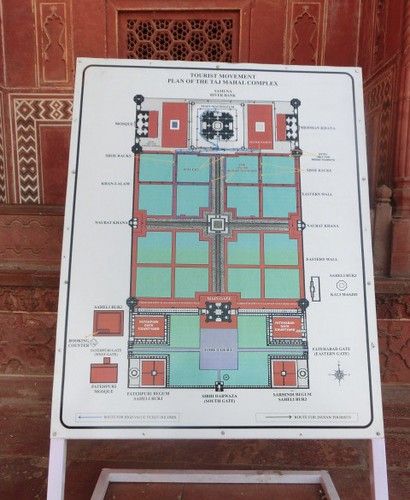 |
Nun also Āgrā, mythenumwabert wegen des Taj Mahals, das seit 1983 auf der Liste des UNESCO-Weltkulturerbes und seit 2007 auch auf der Liste der Neuen Sieben Weltwunder steht. Wir sind ganz frühmorgens dorthin, außer uns waren nur drei weitere Busse da, die Anlage im klaren Morgenlicht und noch nicht von Menschenmassen überlaufen. Mir blieb dann erst mal die Luft weg, beindruckend schon auf Fotos und im Fernsehen, aber so in echt ist es ganz anders! Der Großmogul Shah Jahan ließ das „Denkmal einer großen Liebe“ zum Gedenken an seine mit 39 Jahren bei der Geburt des 14. Kindes verstorbene Lieblingsfrau Mumtaz-i-Mahal („Perle und Auserwählte des Palastes“) kurz nach ihrem Tod 1631 bis 1648 erbauen. Auf dem Totenbett hatte sie sich von ihrem Mann ein Grabmal gewünscht, wie es die Welt zuvor noch nie gesehen hat. Das Mausoleum aus weißem Makranamarmor aus Jodhpur ist 58 Meter hoch und 56 Meter breit, und die vier um das Hauptgebäude herum angeordneten Minarette sind leicht geneigt, damit sie im Falle eines Erdbebens vom Hauptgebäude weg stürzen. Shah Jahan wurde 1658 von seinem Sohn Muhammad Aurangzeb Alamgir entmachtet und verbrachte den Rest seines Lebens als Gefangener im Roten Fort von Agra, mit Blick auf das Taj Mahal. 1666 wurde er dort neben seiner Gattin beigesetzt. Wir blieben ein paar Stunden vor Ort um verschiedene Lichtverhältnisse zu erleben. Und auch um zu sehen wie sich die Stimmung wandelt, wenn die sich Wege um die Wasserbecken mit Besuchern in bunter Festtagskleidung füllen.
 Das Eingangsgebäude zum Areal des Taj Mahal |
 The Gateway, entrance to the grounds of the Taj Mahal |
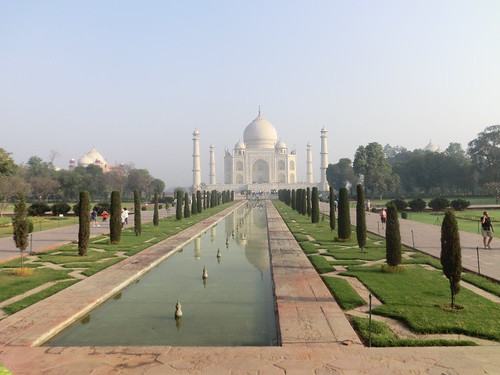 |
 |
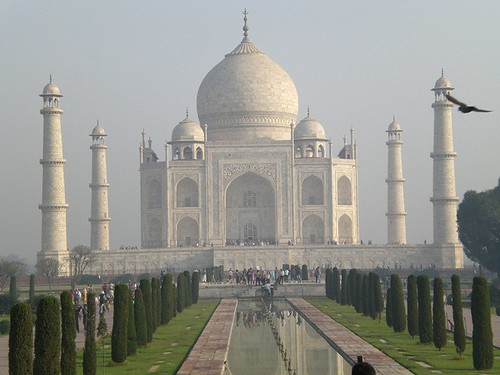 |
 |
 Moschee auf der westlichen Seite des Taj Mahal |
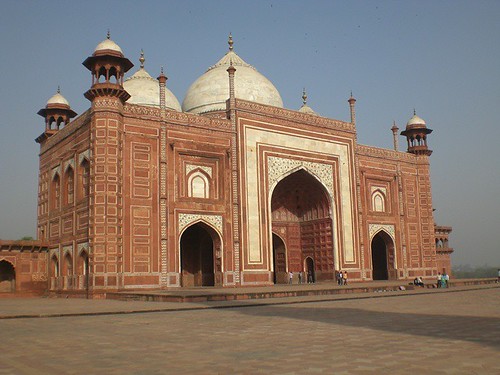 Mosque to the west of the Taj Mahal |
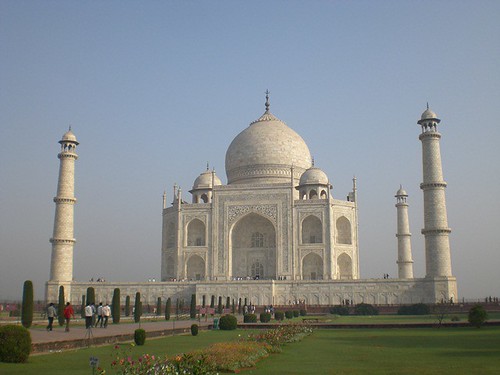 |
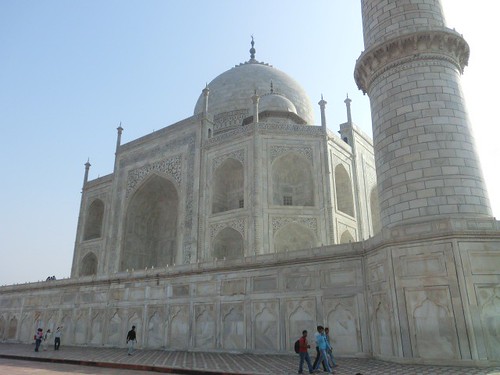 |
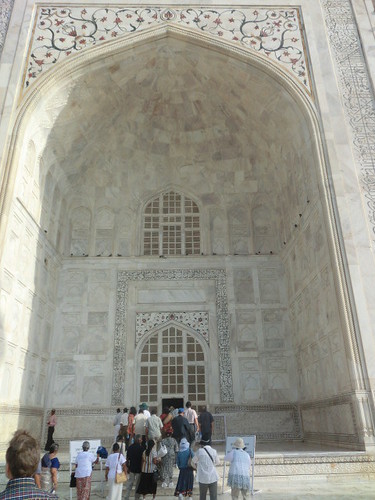 |
 |
 Details der Fassade |
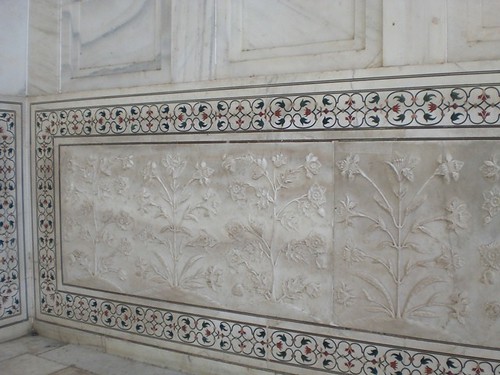 Details of the façade |
 Die Grabdankmäler von Mumtaz-i-Mahal und Shah Jahan. The cenotaphs of Mumtaz-i-Mahal and Shah Jahan. |
 Der Yamuna Fluss an dessen anderem Ufer Shah Jahan das 'schwarze Taj Mahal' als eigene Grabstätte errichten wollte. The Yamuna River on which other bank Shah Jahan had planned to errect the 'black Taj Mahal' as his own mausoleum. |
Now then Āgrā, full of myths about the Taj Mahal, which is listed on the UNESCO World Heritage Site since 1983, and since 2007 also on the List of New Seven Wonders of the World. We were there very early in the morning, only three more buses, the grounds in the clear morning light and not yet overcrowded. I stood there breathless – impressive even in photographs and on television, but in real life it is completely different! Mughal emperor Shah Jahan began building the „Memorial of a great love“ commemorating his favorite wife Mumtaz-i-Mahal (“The Chosen one of the Palace”) who died at the age of 39 after giving birth to their 14th child, shortly after her death 1631 to 1648. On her deathbed she had begged her husband to build a tomb for her, the world has never seen before. The mausoleum of white Makrana marble from Jodhpur is 58 meters high and 56 meters wide, and the four minarets arranged around the main building are slightly tilted so that in the event of an earthquake they fall away from it. In 1658 Shah Jahan was deposed by his son Muhammad Aurangzeb Alamgir and spent the rest of his life as a prisoner in the Red Fort of Agra, in view of the Taj Mahal. In 1666 he was buried there beside his wife. We stayed on site for a few hours to experience different light conditions. And also to see how the mood turns, once the pathways around the pools were filled with visitors in colorful festive clothes.
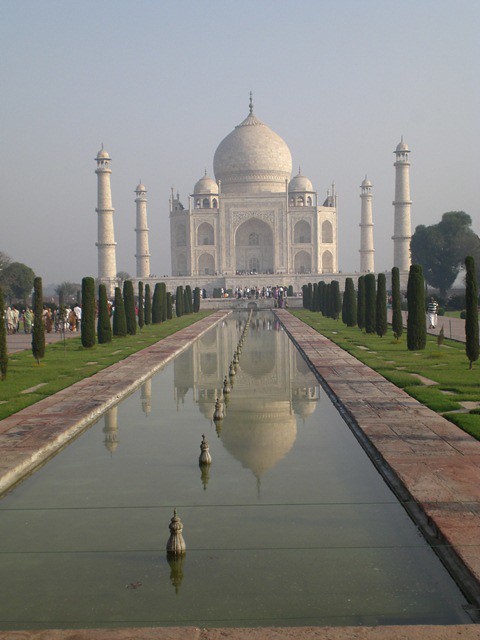 |
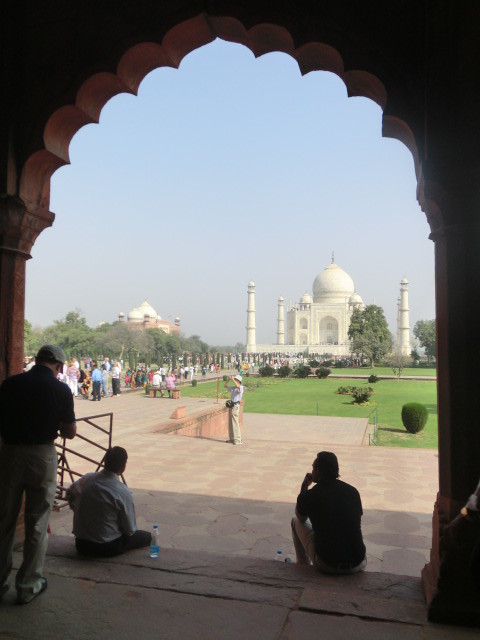 |
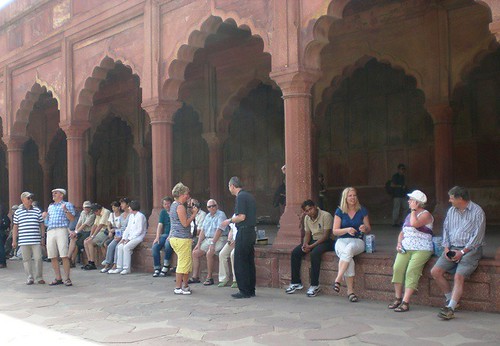 Der grösste Teil unserer Gruppe, noch ganz überwältigt. Most members of our group, still overwhelmed. |
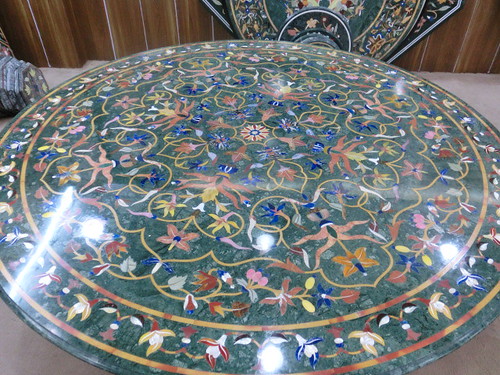 Die Steineinlegearbeiten (Pietra dura) werden heute noch in derselben Technik wie damals angefertigt. The stone inlays are still made in the same technique as back then. |
Dann – zumindest ich – noch ganz überwältigt von dem Gesehenen fuhren wir zum Roten Fort, dem luxuriösen Gefängnis von Shah Jahan, erbaute von dessen Großvater, Kaiser Akhbar. Es liegt auf einem Hügel am Ufer des Yamuna-Flusses, diente im 16. und 17. Jahrhundert den Moguln als Residenz, bis 1648 die Hauptstadt nach Delhi verlegt wurde, und wurde 1983 in das UNESCO-Weltkulturerbe aufgenommen. Shah Jahan ließ die Innenausbauten im persischen Stil mit weißem Marmor verkleiden, ein wunderbarer Kontrast zu den roten Sandsteinen der Außenmauern.
 |
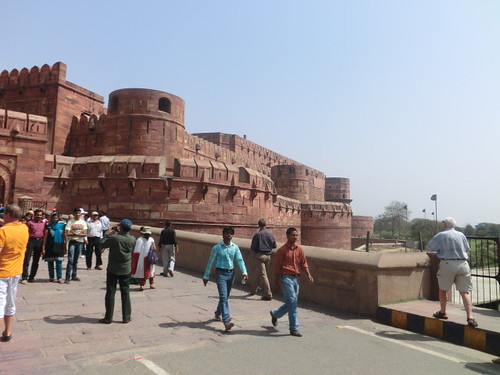 |
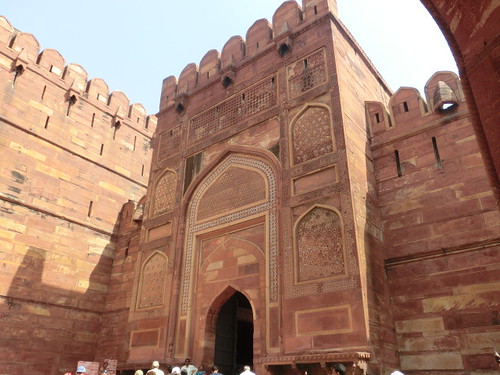 |
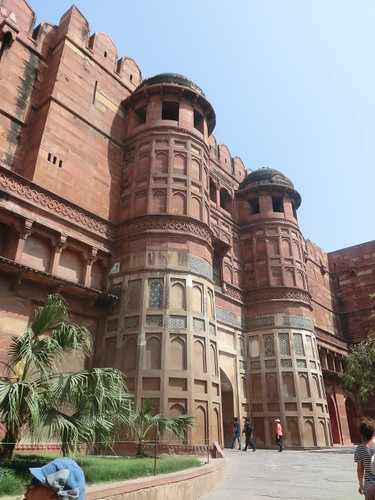 |
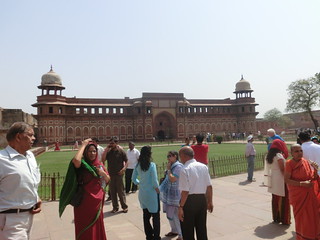 |
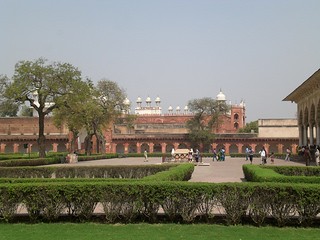 |
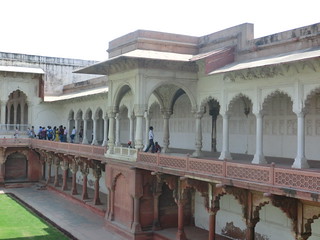 |
 |
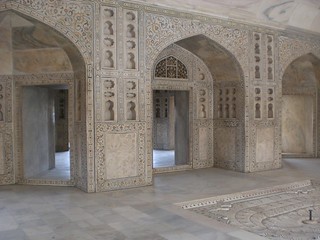 |
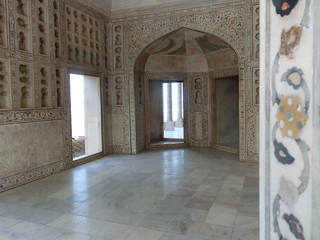 |
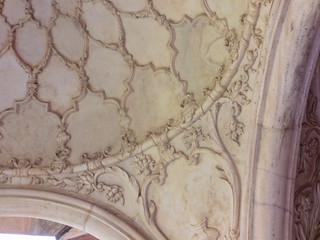 Details verschiedener Deckengestaltungen |
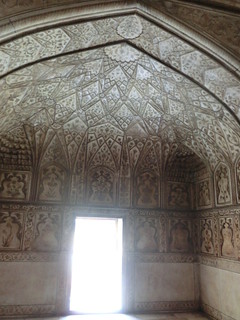 |
 Details of various ceilings |
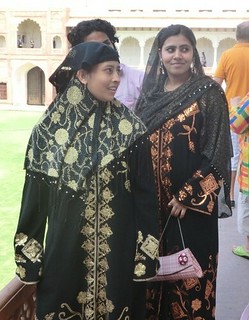 Besucherinnen aus Kalkutta Women from Kolkata (Calcutta) |
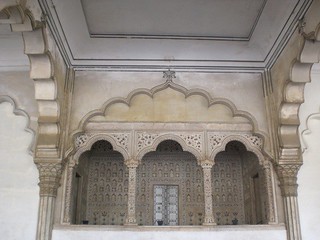 |
 |
 |
 Das ist der Ausblick, den Shah Jahan von seinen Räumen (links) im Roten Fort auf das Taj Mahal hatte. This is the view of the Taj Mahal that Shah Jahan had from his rooms (left) at the Red Fort. |
Abends nach dem Abschiedsessen mit unseren Reiseleitern, die uns zwar noch durch Delhi bis ins dortige Hotel begleiten, sich aber noch vor unserem allerletzten Abend verabschieden würden, auf der Dachterrasse habe ich meine ersten und ganz sicher auch letzten Bidis geraucht, etwas indisches zigarettenähnliches, in dem sich angeblich auch Tabak befinden soll, mich erinnerte der Geschmack eher an ranzige Fußnägel, und wagemutig haben wir weitere indische Biersorten getestet. In Bayern schmecken sie dann doch besser.
After our farewell dinner with our guides, who would guide us through Delhi and into our hotel the next day, but would leave us there before our last evening, I tried my first and definitely last Bidis, Indian cigarette-like somethings which are rumored to contain tobacco – to me they tasted like rancid toenails. And boldly we tested more Indian beers, but the Bavarian beers taste much better.
Im
Garten der Hotelanlage – In the gardens of the hotel complex
 Bougainvillea |
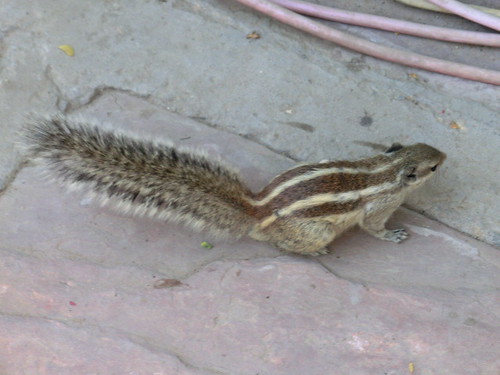 Streifenhörnchen – Chipmunk |
Nur noch ein Tag in Indien, dann Kofferpacken und – – – der Heimflug .... Only one more day in India, then packing the luggage and – – – the flight home ....
Photos:
EFi & AF
| Seite erstellt im August 2012 von EFi | Continue to Delhi | back to preface |
This
site is for entertainment purposes only, there is no intention to make
any profit out of it. The owner of this site accepts no responsibility
for design or any
content relating to this site that is or might be found on external
websites belonging to other people or organizations, nor for any links
to this site.